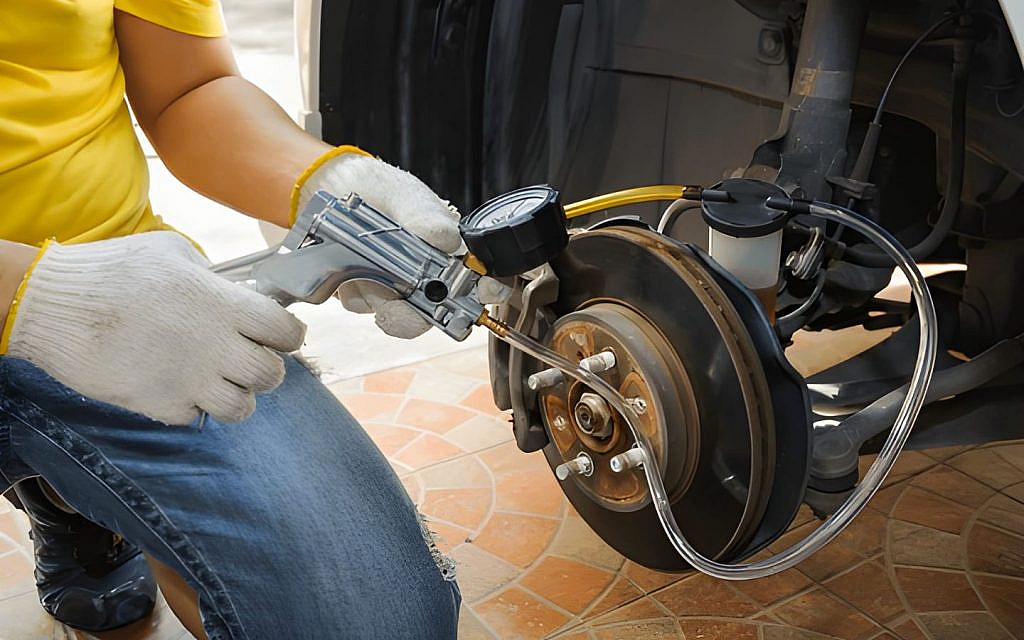How to Fix Spongy Brakes in Your Car
Spongy brakes, also known as soft or mushy brakes, occur when the brake pedal feels soft and sinks lower before slowing down the vehicle. This issue commonly arises due to air trapped in the brake lines, worn-out components or a faulty master cylinder. As it impacts braking performance and road safety, identifying the cause and addressing it promptly is crucial.
6 Different Ways to Fix Spongy Brakes in a Car
Fixing spongy car brakes begins with inspecting the system to identify the root cause. A basic check involves examining the brake fluid level, inspecting brake lines for leaks and observing how the pedal responds when pressed.
Minor issues such as topping up brake fluid or bleeding the brakes can be handled as DIY tasks, while major problems like replacing the master cylinder require professional assistance.
Bleed Brakes
If the brake pedal firms up after a few presses or the brake fluid appears dirty or foamy, bleeding the brakes is the right solution. This process involves releasing trapped air from the hydraulic system to restore proper pressure.
To initiate the brake bleeding process, open the bleeder valve on the brake callipers or wheel cylinder, press the brake pedal to expel the air and old fluid. Once done, close the valve and refill the brake fluid to the recommended level. Besides, the car’s owner manual also outlines the basic brake bleeding procedure, which owners can refer to for guidance.

Replace Worn Parts
If the brake pedal feels soft along with squeaking noises, increased stopping distance or uneven braking, worn components are likely the cause. Damaged brake pads or warped rotors reduce braking efficiency and lead to uneven pressure distribution.
To resolve this, remove the wheel and inspect the pad thickness and rotor surface for wear or distortion. Replace any worn components with quality new or used car brake parts for sale in the UAE and increase the braking performance.
Refill Brake Fluid
Low brake fluid level is another common cause of spongy brakes. To check, park the vehicle on a level surface and inspect the brake fluid reservoir. The fluid should be close to the maximum mark indicated on the container. In case the fluid is below the minimum level, top up with the recommended brake fluid until it reaches the maximum mark.
Fix Lines and Hoses
If spongy brakes are accompanied by oil drips, damp spots or a faint chemical odour near the wheels, it may indicate a brake fluid leak from the lines or hoses.
Inspect the brake lines running from the master cylinder to each wheel for signs of corrosion, cracks or wear. Replace any damaged metal lines or rubber hoses immediately to prevent further fluid loss and restore proper hydraulic pressure in the braking system.
Inspect Callipers
If the vehicle pulls to one side when pressing a spongy brake pedal or one wheel is more responsive than others, faulty callipers could be the cause.
Inspect the callipers for signs of rust, corrosion or physical damage. Minor corrosion can be resolved by cleaning and lubricating the callipers. However, severely damaged ones should be replaced.
Repair or Replace Master Cylinder
When fixing spongy car brakes, if all the other components are functioning properly, the culprit can be a master cylinder. The cylinder generates hydraulic pressure by pushing brake fluid through the system. When its internal seals wear out or leak, the fluid pressure drops, leading to a soft brake pedal without visible leaks.

In most cases, replacing the bad master cylinder is an ideal solution, though minor seal issues may be repaired. Since the master cylinder is a complex component, it’s recommended to have it replaced or repaired by a qualified mechanic.
FAQs
How do I know if my car has spongy brakes?
Spongy brakes can be identified if the pedal feels soft, sinks deeper than usual or needs to be pumped to build pressure. Other signs include increased stopping distance, uneven braking or the brake warning light turning on.
What causes spongy brakes in a car?
Spongy brakes are usually caused by air trapped in the brake lines, low or contaminated brake fluid, worn-out components or a faulty master cylinder.
Do I need to bleed my brakes if the pedal feels spongy?
Yes, bleeding the brakes helps remove trapped air from the hydraulic system and often restores pedal firmness. However, it may not be effective if worn-out components or other mechanical issues cause the sponginess.
Are spongy brakes dangerous to drive with?
Yes, they reduce braking efficiency and increase stopping distance, making driving unsafe.
Should I take my car to a mechanic for spongy brakes?
If basic fixes like bleeding or refilling fluid don’t help, it’s suggested to consult a qualified mechanic to repair the car’s brakes.
How often should brake fluid be changed to avoid spongy brakes?
Brake fluid should typically be replaced every two years or as recommended by the vehicle manufacturer to maintain proper braking performance.
These are some effective ways to fix spongy car brakes, along with the key symptoms to identify the issue. Although spongy brakes may seem like a minor fault, addressing them promptly is essential to maintain smooth and reliable braking performance. Braking efficiency plays a crucial role in road safety and also reflects the vehicle’s performance. When considering a used car for sale in the UAE, the efficiency of its brakes is among the first things to check.
Besides braking efficiency, there are multiple other factors to consider when buying a used car that buyers must be aware of.
Stay connected with dubizzle’s auto blog for some effective brake system maintenance tips.
Comments
Post a Comment